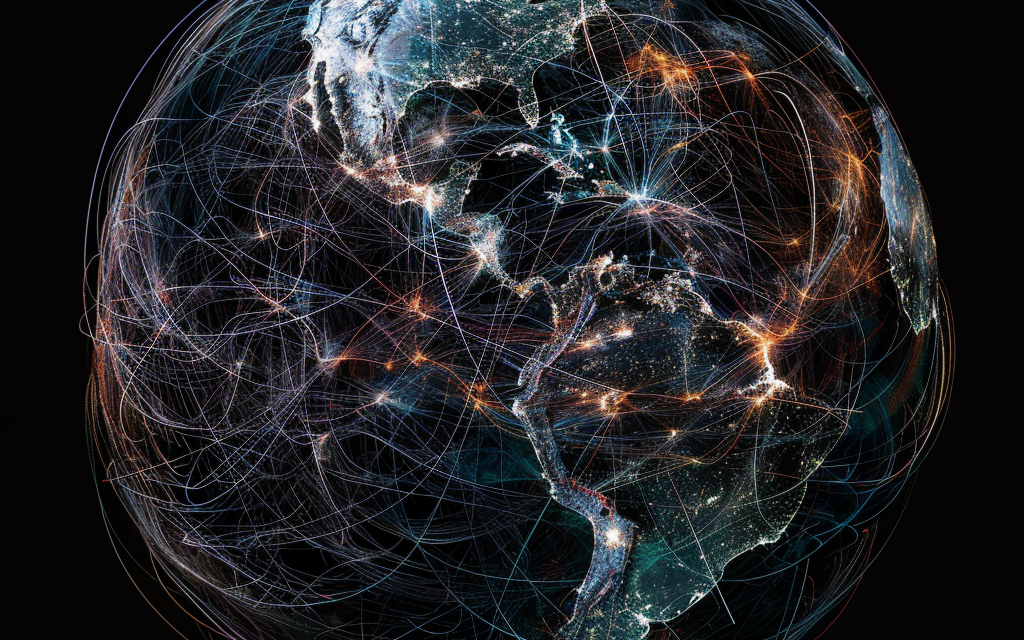Introduction
In today’s world, where the Internet is as essential as air and water for our digital lives, it’s hard to imagine a time when it didn’t exist. From its humble beginnings as a military project to its role as the global information superhighway, the Internet’s journey is a fascinating tale of innovation, collaboration, and a bit of serendipity. This guide will take you on a whirlwind tour through the history of the Internet, introducing the visionaries who paved the digital road and exploring how it became the indispensable tool it is today. Buckle up; we’re about to take a ride through the digital revolution.
Pre-Internet Technologies
Long before the digital hum of the Internet filled our lives, humanity’s desire to connect across vast distances sparked a series of innovations that would eventually lead to the creation of the Internet. The journey began with primitive yet ingenious methods like smoke signals and drumbeats, ancient civilizations’ versions of instant messaging. Fast forward to the 19th century, when the telegraph revolutionized long-distance communication, allowing messages to be transmitted over wires through a series of electrical pulses. This was the world’s first taste of real-time communication, albeit in Morse code.
The telephone, invented by Alexander Graham Bell in 1876, brought a more personal touch, transmitting the human voice across cities and eventually continents. This magical ability to talk to someone miles away laid the groundwork for modern telecommunications. However, it was the advent of computers and their ability to process and store vast amounts of information that truly set the stage for the Internet. Early computers were massive, expensive, and primarily the domain of governments and large institutions.
Yet, the potential for these machines to communicate with each other sparked the imagination of scientists and engineers. The development of packet switching technology, where data is broken down into packets and sent through a network, was a key breakthrough. It allowed for efficient, reliable data transmission, a fundamental principle that would underpin the future Internet. These pre-Internet technologies, from the telegraph to packet switching, were not just stepping stones but leaps toward a connected world.
The Pioneers of the Internet
The tapestry of the Internet’s history is woven with the contributions of visionary pioneers. Among them, the ARPANET project stands out as a cornerstone. Funded by the U.S. Department of Defense’s Advanced Research Projects Agency (ARPA), ARPANET was the first operational packet-switching network, and it demonstrated the feasibility of global computer networks. The project’s success was a collective effort, but two names shine particularly brightly: Vint Cerf and Bob Kahn.
Cerf and Kahn introduced the Transmission Control Protocol and the Internet Protocol (TCP/IP), the protocol suite that became the language of the Internet, allowing diverse computer networks to communicate. Their innovation was akin to creating a universal translator for computer networks, breaking down barriers between different systems. This breakthrough earned Cerf and Kahn the moniker “Fathers of the Internet,” a title that only begins to capture their monumental impact on the digital world.
From ARPANET to the Internet
The transformation of ARPANET into the Internet was a paradigm shift that turned a specialized research network into the global communications backbone we know today. The pivotal moment came on January 1, 1983, known as “flag day,” when ARPANET officially adopted TCP/IP, effectively birthing the modern Internet. This transition marked the beginning of an unprecedented era of connectivity, allowing not just academic and military institutions but also businesses and eventually the public to join the digital revolution.
The role of TCP/IP in this transformation cannot be overstated. By providing a standardized set of rules for data transmission, it allowed disparate networks to interconnect seamlessly, creating a network of networks—the Internet. This scalability and flexibility were revolutionary, enabling the Internet to grow beyond its creators’ wildest dreams.
As the Internet emerged from the confines of ARPANET, it began to reshape society. The digital landscape, once the realm of researchers and government agencies, expanded to include everyone from entrepreneurs dreaming of dot-com success to everyday users logging on to explore the World Wide Web. The Internet’s journey from ARPANET to a global utility is a testament to human ingenuity and the power of collaboration, setting the stage for an interconnected world that has revolutionized how we live, work, and communicate.
The World Wide Web: Bringing the Internet to the Masses
The advent of the World Wide Web in the early 1990s, thanks to Tim Berners-Lee, marked a seismic shift in the Internet’s evolution, transforming it from an arcane network understood by few to a ubiquitous platform that reshaped how society functions. Berners-Lee, a British computer scientist at CERN, envisioned a global information space where knowledge and communication could flow freely. He introduced the HyperText Markup Language (HTML), which became the cornerstone of web development, and the concept of web browsers, which served as the window to this vast new world. Suddenly, the Internet was no longer just for sending emails or transferring files but a space where anyone could explore, learn, and connect. The Web democratized information, breaking down barriers and making it accessible to the masses, thereby igniting a digital revolution that continues to this day.
The Internet Boom: Expansion and Commercialization
The 1990s were a whirlwind period for the Internet, characterized by unprecedented growth and the rise of the dot-com era. Entrepreneurs and businesses quickly recognized the Web’s potential, leading to a frenzy of investment and speculation. Start-ups with a “.com” in their name attracted massive investments, fueling a bubble that seemed to promise endless possibilities. This era saw the birth of many Internet giants and the laying of the digital economy’s foundation. However, the bubble’s burst in the early 2000s was a harsh reality check, leading to significant financial losses and the collapse of numerous companies. Despite this setback, the period was crucial in cementing the Internet’s role in commerce and society, paving the way for the resilient, diverse digital marketplace we have today.
Innovations and Milestones
Since its inception, the Internet has been a hotbed of innovation, profoundly changing how we communicate, conduct business, and entertain ourselves. Social media platforms have redefined personal interactions, creating global communities and reshaping social dynamics. E-commerce has revolutionized retail, allowing anyone to shop from anywhere, anytime. Streaming services have transformed media consumption, making vast libraries of music, movies, and TV shows instantly accessible. These advancements have not only altered consumer habits but have also driven significant economic shifts, creating new industries and reshaping traditional ones. The Internet’s capacity for continual reinvention is one of its most enduring characteristics, fueling its growth and ensuring its central role in modern life.
Challenges and Controversies
Despite its benefits, the Internet’s journey has been fraught with challenges. Privacy concerns and security threats have grown in tandem with the Internet’s expansion, prompting debates on data protection and cybersecurity. The digital divide remains a significant issue, highlighting disparities in Internet access and technological literacy across different regions and demographics. The debate over net neutrality, the principle that Internet service providers should treat all data equally, has raised questions about the Internet’s future as an open platform. These challenges underscore the complexities of governing a global resource, emphasizing the need for continued dialogue and collaboration to ensure the Internet remains a force for good.
The Future of the Internet
Looking ahead, the Internet stands on the brink of another evolutionary leap. Emerging technologies like artificial intelligence, blockchain, and quantum computing promise to redefine its capabilities and applications. The potential for more personalized, secure, and efficient online experiences is enormous, suggesting a future where the Internet is even more integrated into our daily lives. However, these advancements also raise important ethical and practical questions, challenging us to balance innovation with responsibility. As we navigate this future, the Internet’s role in shaping our world remains undiminished, promising endless possibilities and new frontiers to explore.
Conclusion
From its origins as a network of networks to its status as the backbone of the global information economy, the Internet’s story is one of human ingenuity and collective endeavor. As we reflect on this journey, it’s clear that the Internet is more than just a technology; it’s a catalyst for change, driving humanity forward into an increasingly digital future. The Internet’s tale is far from over, and its next chapters promise to be as exciting as those that have come before.





